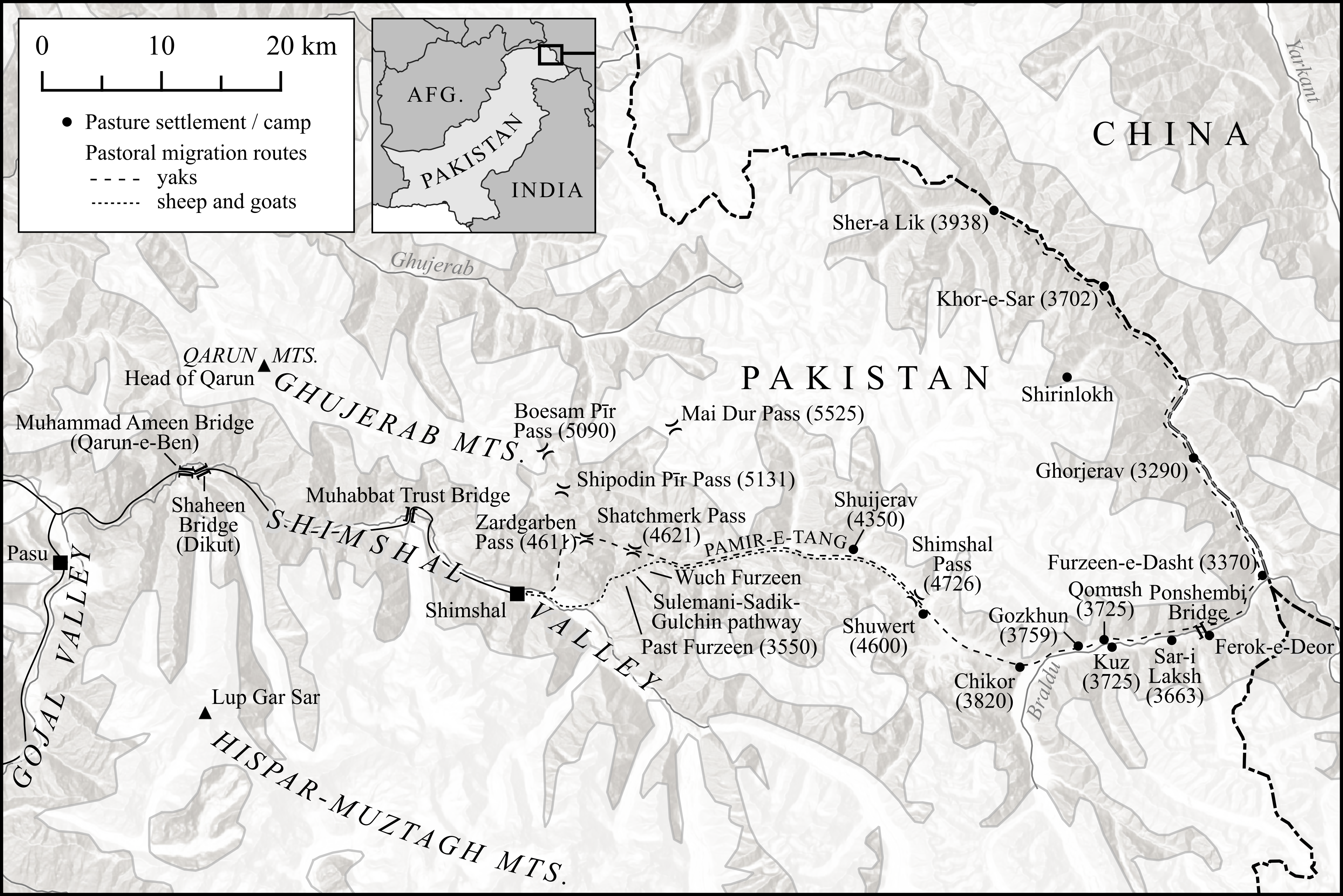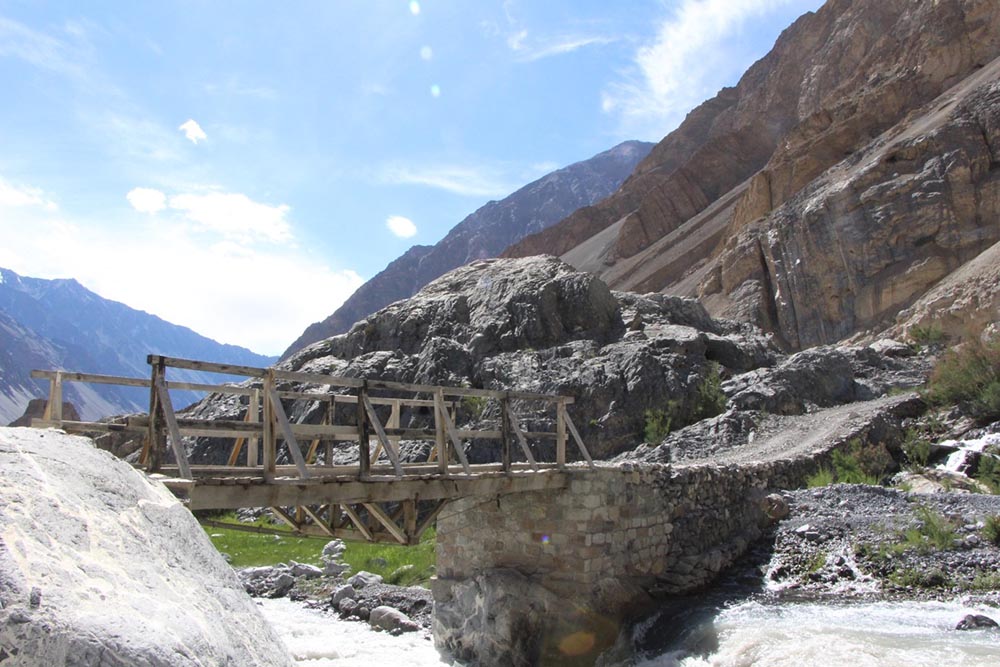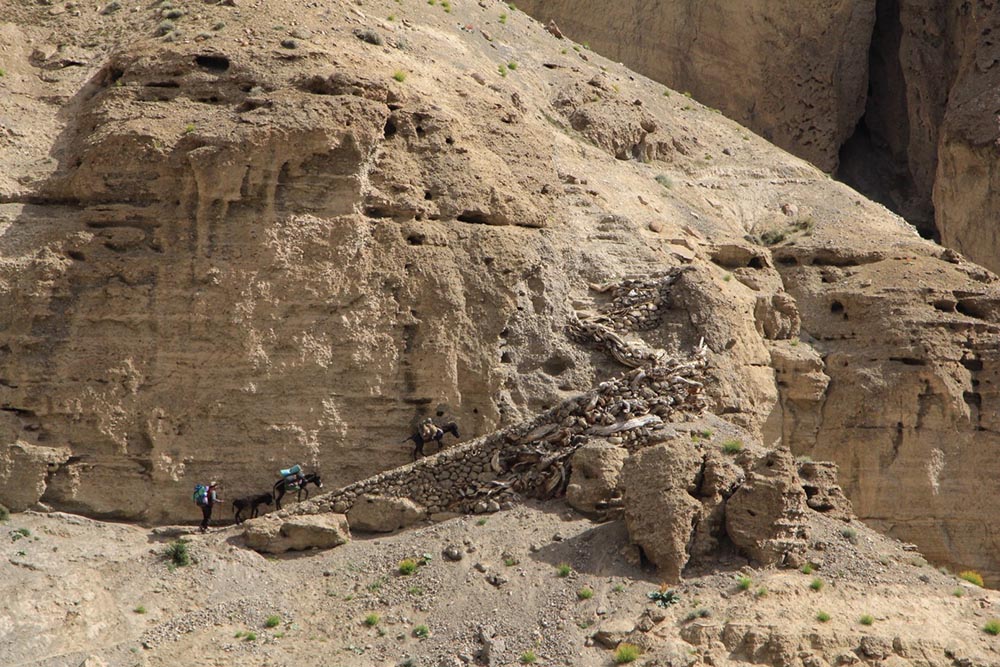Infrastructure as Gifts in the Karakoram
In Shimshal Valley in the Karakoram, infrastructures tell the story of the many forms of solidarity the locals mobilised to build them. Whether walking along the paths and bridges leading to refuges and pastures or along the irrigation canals running alongside the fields, walkers stand ready to clear away the stones and landslides that continually obstruct their infrastructure. When locals need to repair foundations or build new ones, they mobilise a donation system and name the structures they build after someone, creating places of prayer and memory.
Giving while journeying
Shimshal village in Gilgit-Baltistan district in northeastern Pakistan is home to about 225 houses built on a narrow strip of land wedged between the mountains. Being able to channel meltwater from the surrounding glaciers has enabled its inhabitants to irrigate some 150 hectares of potato, barley, and wheat fields. It is also surrounded by pastures in a territory of about 2700 km2, where the people herd yaks, sheep, and goats.
Since the beginning of my fieldwork in October 2011, I have been interested in how the herders relied on their relationships of kinship and friendship to face the obstacles they encountered on their journeys together. In this arid and sometimes hostile environment, rockfalls, landslides, and snowstorms are a constant challenge for the herders and their flocks. In rare cases, the landslides can block or destroy parts of paths, and river flooding can wipe out irrigation channels or even houses in the village. To cross a flooded river, repair a stretch of road, or brave a snowstorm in the cold, the inhabitants mobilise to face the obstacle together. This attitude of attention to the environment and of caring for other people who travel through it is called nang xak (“to stand by someone”) in Wakhi (an oral language), a term that invites us to think about solidarity as an indissociable aspect of journeying.
In 2016, I became fully aware of the importance of how acts of solidarity along the road manifest themselves when travelling to Shimshal from the city of Aliabad, in the Hunza Valley. With two other residents, we took the Karakoram Highway that connects Kashgar in Xinjiang to Mansehra in northern Rawalpindi and runs through the Hunza Valley. We picked up the driver’s brother and his cousin on the way and turned east to the Shimshal Valley. After about only thirty minutes, we faced a landslide that blocked the road. Two other jeeps ahead of us had also been forced to stop. Very quickly, the young men left their vehicles and formed a circle around the smallest rock to get a better look. The elders stood behind the young men and pointed out the weak spot on the boulder. The most daring youths tried to smash the rock with a bit of rubble that they passed around, and as they did, it became emblematic of the bond that connected people, just as the road itself was our mutual connector and the ground on which we generated our social life. Roads, rocks, and rubble thus revealed a form of agency – they were central to collective mobilization and the enactment of solidarity.
The “Right Path”
Herders are accustomed to mountain footpaths that navigate the rugged landscape in winding ways and whose narrowness often forces the walkers to adopt a certain position in relation to one another. This exercise, in hierarchical patriarchal communities like Wakhi Ismaili of Shimshal, is far from trivial, for one’s position depends on one’s age and gender, but also on the prestige that one receives by performing actions in accordance with Ismaili principles. Like any other “imaginary,” as anthropologist Maurice Godelier explains, it is a founding myth that associates the human social hierarchy with the one which governs the world of metahumans, and thereby gives meaning to relations of sovereignty – in other words, the political and religious relations that shape all social positions in a given society. 1
One of the distinctive elements of the Ismaili community is that its spiritual guide, the Imam (descended from the line of Ali, the Prophet’s son-in-law), guides his followers by delivering his farman (“messages”) every new moon through a complex network of religious institutions. 2 These messages are religious values and practical pieces of advice that constitute a guideline for the material success and spiritual development of Ismaili followers. The inhabitants summarize it as “the Right Path.” In Shimshal’s daily life, it is by taking care of horizontal relationships developed with other beings that one progresses vertically towards God. Wakhi herders and farmers embody these values through walking every time they take up their spatial positions on roads and pathways and act accordingly, in solidarity.
People progress in society through their cooperation with others as they walk with them, in accordance with this social imaginary, and this is what people in Shimshal consider to be the Right Path. The more they give of themselves to help others to safely reach their destination, the more deference and social recognition they receive, and the more they progress spiritually. In this context, social recognition is about performing a gesture of deference towards someone else that symbolises and reproduces a particular social order. 3 In other words, as they confront obstacles along the way, the inhabitants act according to the affordances of footpaths and roads, but they also conform to the social hierarchy.
Infrastructure as gift
Clearing a road blocked by falling stones, unblocking an irrigation canal obstructed by a landslide, or reinforcing the weakened walls of an irrigation canal following a heavy influx of water are ordinary constraints for the inhabitants of Shimshal. However, while it just takes a few people to carry out these actions, these individuals would not be able to repair such structures entirely or build new ones on their own. The construction and repair of these structures is virtually only possible through a complex system of donations.
This was especially true with the mule track, the route that preceded the Shimshal road [Fig. 1]. Before 1982, the people who made the journey to Shimshal Valley would walk on this track for three days, and many elders still suffer knee pain from carrying too many heavy loads of material and food over the years. They would have to cross the Shimshal river 40 times, mostly fording, risking being swept away at any moment by the powerful flow of icy waters. To ease the many crossings along this mule track, the locals built wooden bridges and opened new paths along the mountain wall, sometimes even digging stairs in the rock. To do so, they mobilised a specific form of gift-giving called nomʉs – not unlike the Arabic term nāmūs (ناموس, “law, honour”), itself derived from the concept of nomos (νόμος) in Greek, that is, “the law or social rule.” Simply put, the rule of nomʉs is that “the family gives wealth and the volunteers give health.” In other words, “the family gives its resources and the workers their labour force.” Usually, members of an extended family (sukuin) invite other lineages of the village to share a meal, during which they announce their intention to build a collective edifice. The sponsoring family makes food as well as material and financial resources available to the other households, who will in turn contribute their labour force to build the structure. Each construction that the nomʉs makes possible will become a place of memory and prayer and, by making the journey easier, will encourage walkers to address prayers and wishes to the namesake and to all those who contributed to its development. Similarly to nang xak, the organisation of gifts in a nomʉs occurs at the crossroads of the inhabitants’ physical and spiritual journey. By building a structure for the community, sponsors and builders trace their spiritual way to God, and when they walk on their mountain footpaths, they pray for the salvation of the eponym’s soul.
If the notion of nang xak brings to the fore the relationship between giving and walking, that of nomʉs does so with regard to giving and infrastructure. Nomʉs depends on the negotiation between the participants who combine two types of gift (financial and material resources and labour force). Therefore, while nang xak is a pre-reflexive yet profoundly social form of giving, nomʉs is the result of a complex decision-making process between the participants. The two notions are nonetheless inextricably linked. The nomʉs reflects a collective consensus and action on the built environment of the community territory in accordance with the Ismaili imaginary, but it is based equally on a practical knowledge of the built environment. People make the decision to build a nomʉs whenever a group of walkers belonging to a particular lineage finds a new path to a pasture, or when a path that members of the lineage use collapses, or if they seek to gain more arable land by building a new irrigation canal. In all these circumstances they can make their interests converge with those of other lineages to honour the name and save the soul of one of their own.
The circulation of the gifts on the roads
According to some of the people with whom I spoke, the inhabitants had been practicing this form of giving since they settled in the village, which dates back to the beginning of Hunza principality in the 15th century. Others refer to oral testimonies and to still-visible vestiges, the oldest of which date from the beginning of the 20th century. What seems most important to note, perhaps, is that although the way people combined their gifts has remained relatively similar, the type of infrastructure built, the groups participating in nomʉs, and their motivations to do so have changed since the beginning of the 20th century with the comings and goings of the inhabitants on the Karakoram road network.
By connecting the villages and pastures of the rural areas to the cities, roads have become the ground on which the inhabitants have made unprecedented cultural contact with other inhabitants and communities of the region. As Harvey, Bruun Jensen, and Morita have argued, infrastructure and society mutually shape one another throughout time. 4 In the Karakoram, and among the Wakhis in particular, tracing the development of herders’ road networks thus amounts to charting a history of these forms of solidarity and belonging to the territory and the environment.
In Shimshal, what is known today as nomʉs seems to have been imposed on subjects by the prince Muhammad Nazim Khan of Hunza (1892-1938), primarily to serve the interests of his state. To do so, he relied on the coercive power relationship his predecessors had enforced in Wakhi communities at the turn of the 19th century. This power relationship resulted in the imposition of annual taxes on Wakhi communities of the valley, which generated a stratification of lineages between those who could pay them and those who could not. Those who could not pay the tax directly had to carry their taxes on foot to the prince’s court in the form of agriculture and livestock. 5 It was from among the wealthiest lineages that the prince appointed a representative to implement this policy. It was also through them that the prince forced his subjects to accept material resources and to use them to build structures. The prince himself sponsored at least two such structures in Shimshal: a stretch of pathway named after his mother, Qorban Begum, and a bridge on the old mule track built in the name of Muhammad Ameen, the father of Ponshembi, the village chief. Just after the completion of these works in approximately 1920, Ponshembi and his son, Ghulam Nasir, sponsored another nomʉs, a bridge over the Shimshal river far in the east, close to Darwaza, the place where the principality’s defensive walls stood [Fig. 2]. While the first two were intended to facilitate the flow of taxes, the third was intended to provide easier access to the principality’s only salt mines, from which the less fortunate lineages of Shimshal had to extract the precious mineral and bring it to the prince.

Fig. 2: Map of Shimshal Valley
Nomʉs remained in place even after the last prince of Hunza was deposed in 1974 and the Hunza Valley was administratively integrated into Pakistan. Henceforth, the sponsors would mainly be the wealthiest lineages of the village, even though many historical structures prove that the other lineages contributed greatly to infrastructural development. Even when Pakistan and the NGO the Aga Khan Rural Support Programme (AKRSP) became involved in the development of the Shimshal road, which would replace the old mule track, the nomʉs proved essential in filling in many sections. This can be seen today with the Muhabbat Trust Bridge built in 1999 [Fig. 3], a structure whose name pays tribute not only to its eponym, Muhabbat, but also to the collaboration between the locals and the members of the AKRSP.

Fig. 3: The “Muhabbat Trust Bridge”
Walking and the archaeology of forms of giving
Highways, asphalt-paved or stone roads, trails, or pathways differ in terms of the materials from which they are made, the construction techniques used to build them, and the religious, political, or even geostrategic reasons that prompted workers, sponsors, or contractors to devote themselves to the work. At Shimshal, this diversity also extends to the mountain footpaths themselves. Their typology is so rich that in July 2016, while we were visiting the summer pastures, one of my partners ventured a comic comparison to answer my umpteenth question about the history of mountain paths: “You French-speakers have 400 names to describe your cheeses, so we have just as many to name our pathways.” In the Karakoram, when you hit the road, you have to expect to travel on many different routes. This diversity does not easily lend itself to hierarchisation. Not all pathways become roads as the Shimshal mule track did, and when the Shimshal road is blocked for long weeks by a landslide that a few travellers are unable to clear, the local people follow new, ephemeral trails.
The locals rebuild the sections of path destroyed by rockfalls, landslides, or erosion, and do not hesitate to rename the sections they improve. This happened to an old perien (“staircase-shaped pathway”) that a family, the Bari, built in the late 1960s in the name of a woman, Gulchin [Fig. 4]. Between 2009 and 2012, the woman’s son Sadiq rebuilt the lower section in the name of his wife, Sulemani, and the upper one in his own name. This is how pathways create a palimpsest, and the walkers who tread them retrace the history of their builders, of the different infrastructures, of their users, and finally, of the paths themselves. A history of these pathways must therefore consider them not only as connectors between places, but also as places of connection between humans and non-humans, such as animals, dead people, or deities.

Fig. 4: The Sulemani and Sadiq Pathway built
between 2009 and 2012 on the old Gulchin
Pathway, constructed for the first time in the
late 1960s. Gulchin was the mother-in-law of
Sulemani and the mother of Sadiq.
The history of the diversity of roads and pathways sheds light on the multiple forms of solidarity that builders mobilised to develop and rebuild them. The descriptions given above demonstrate the reciprocal role of roads and paths in the implementation of forms of solidarity, whether the latter be the result of pre-reflexive, direct, immediate, phenomenal, and ephemeral collective action, or rather planned, thought-out, and strategic action. Surveying the roads and paths ultimately amounts to experiencing them as agents who generate forms of solidarity. It also means tracing their history, which, like the paths, has nothing linear about it and is necessarily linked to the political and religious relationships of its protagonists. 6
Thibault Fontanari is an anthropologist. He is currently a visiting lecturer at the Université catholique de Louvain in Belgium. His research focuses on giving, walking, roadbuilding, and oral literature in the Karakoram Mountains in Pakistan. He obtained his PhD at UCLouvain in 2018 on a doctoral fellowship from the Fund for Scientific Research (F.R.S-FNRS). He continued his research at Harvard University as a Fulbright visiting scholar and BAEF Fellow in 2019 and 2020, and then at the Rachel Carson Center for Environment and Society (LMU) in 2022. Email: thibault.fontanari@uclouvain.be